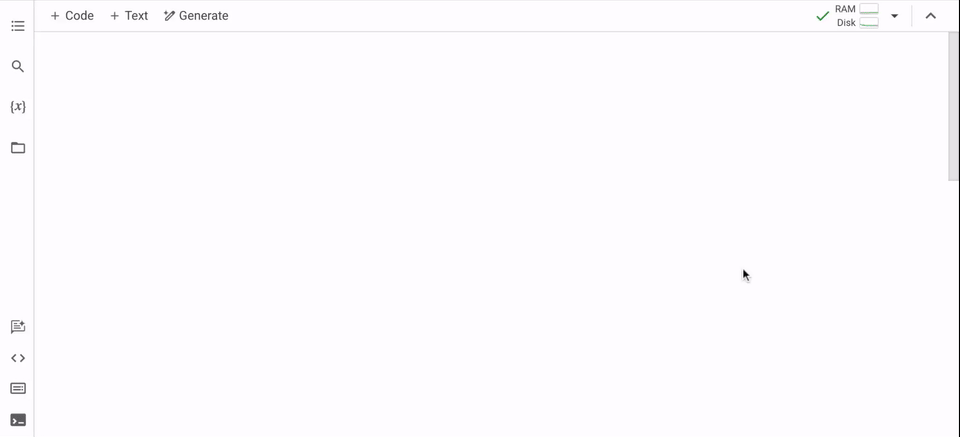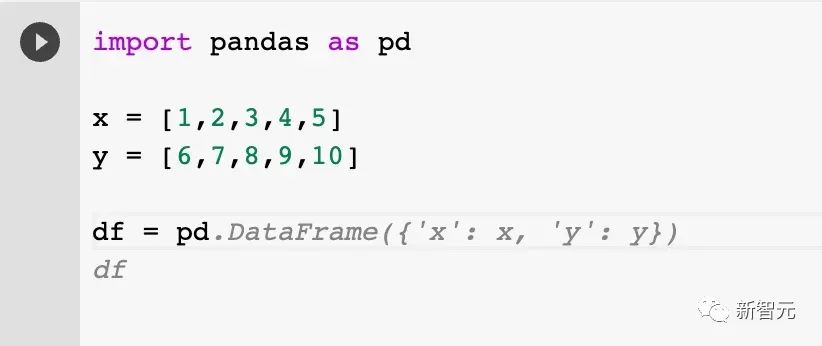 Technology peripherals
Technology peripherals
 AI
AI
 AI automatic coding will be online! Google Colab is stronger than Github Copilot, and programming efficiency will be drastically improved
AI automatic coding will be online! Google Colab is stronger than Github Copilot, and programming efficiency will be drastically improved
AI automatic coding will be online! Google Colab is stronger than Github Copilot, and programming efficiency will be drastically improved
The Google version of Github Copilot is here!
On May 17, Google announced that Google Colaboratory (Colab) will soon add a new AI coding function-
code generation, code Completion, code chatbots, you name it.
Coupled with the all-cloud Jupyter notebook environment provided by Colab before, developers can easily use Keras, TensorFlow, PyTorch, OpenCV and other frameworks to run on the GPU resources provided by Google. Development of deep learning applications.
And all of this is free! (Paid users can currently experience it early)
Face-to-face Microsoft Github Copilot
At the just-concluded 2023 I/O conference, Google released a solution that can be used in duels PaLM 2, the base model of GPT-4.
Based on PaLM 2, after fine-tuning using a large amount of high-quality code data, the new "Vincent Code" model Codey was born.
These new features of Colab are powered by Codey.
Codey code generation model supports more than 20 coding languages, including Go, Google standard SQL, Java, Javascript, Python and Typescript, etc.
Through real-time code completion and generation, Codey can help users complete development work faster while improving code quality.
The most important thing is that this model is also specially optimized for various functions of Python and Colab.
It can be seen that Google is really attentive to the experience of developers of deep learning applications and Python.

##GitHub Copilot
Back in 2021, Github released A preview version of the AI code generation tool Copilot.
In March this year, Copilot Chat, powered by GPT-4, was launched, which can help developers write code and debug in chat mode.
For example, developers can highlight a piece of code in the editor and then let Copilot Chat refactor or debug it.
Code generationGoogle said that Colab with AI support can reduce the burden of developers writing repetitive code, so that developers can focus on more valuable programming content and data science content.
Among them, the highest priority is code generation.
After the upgrade, a new "Generate" button will appear in the notebook of Colab.
Users can enter whatever they want in natural language there, and then AI will generate the corresponding code based on this text prompt.

When entering the code, Colab will provide the next code based on the context. Code suggestions are provided.

In addition, Google will also add a programming-specific chatbot to Colab.
Users can talk directly to the AI to get help with debugging, documentation, learning new concepts, and other issues.
For example, "How do I import data from Google Sheets?"
Or, "How to filter Pandas DataFrame?"
Available to everyone
Google said that anyone who wants to learn or use Python can do it Use Colab with zero threshold and get the blessing of this machine learning application driven by high-performance GPU.
And more new features are on the way, which will make developers’ work in the field of machine learning more convenient.
It is understood that Colab’s monthly active student users alone are in the millions.
Then the question is, when can I use Colab with these functions?
According to Google, access to these features will be gradually rolled out over the next few months, with paid users in the United States able to start the experience first, and then free users will be able to use it.
Users in other regions will also be able to experience these features in the near future.
Reference:##https://www.php.cn/link /9a555403384fc12f931656dea910e334
The above is the detailed content of AI automatic coding will be online! Google Colab is stronger than Github Copilot, and programming efficiency will be drastically improved. For more information, please follow other related articles on the PHP Chinese website!

Hot AI Tools

Undresser.AI Undress
AI-powered app for creating realistic nude photos

AI Clothes Remover
Online AI tool for removing clothes from photos.

Undress AI Tool
Undress images for free

Clothoff.io
AI clothes remover

AI Hentai Generator
Generate AI Hentai for free.

Hot Article

Hot Tools

Notepad++7.3.1
Easy-to-use and free code editor

SublimeText3 Chinese version
Chinese version, very easy to use

Zend Studio 13.0.1
Powerful PHP integrated development environment

Dreamweaver CS6
Visual web development tools

SublimeText3 Mac version
God-level code editing software (SublimeText3)

Hot Topics
 1385
1385
 52
52
 Centos shutdown command line
Apr 14, 2025 pm 09:12 PM
Centos shutdown command line
Apr 14, 2025 pm 09:12 PM
The CentOS shutdown command is shutdown, and the syntax is shutdown [Options] Time [Information]. Options include: -h Stop the system immediately; -P Turn off the power after shutdown; -r restart; -t Waiting time. Times can be specified as immediate (now), minutes ( minutes), or a specific time (hh:mm). Added information can be displayed in system messages.
 How to check CentOS HDFS configuration
Apr 14, 2025 pm 07:21 PM
How to check CentOS HDFS configuration
Apr 14, 2025 pm 07:21 PM
Complete Guide to Checking HDFS Configuration in CentOS Systems This article will guide you how to effectively check the configuration and running status of HDFS on CentOS systems. The following steps will help you fully understand the setup and operation of HDFS. Verify Hadoop environment variable: First, make sure the Hadoop environment variable is set correctly. In the terminal, execute the following command to verify that Hadoop is installed and configured correctly: hadoopversion Check HDFS configuration file: The core configuration file of HDFS is located in the /etc/hadoop/conf/ directory, where core-site.xml and hdfs-site.xml are crucial. use
 What are the backup methods for GitLab on CentOS
Apr 14, 2025 pm 05:33 PM
What are the backup methods for GitLab on CentOS
Apr 14, 2025 pm 05:33 PM
Backup and Recovery Policy of GitLab under CentOS System In order to ensure data security and recoverability, GitLab on CentOS provides a variety of backup methods. This article will introduce several common backup methods, configuration parameters and recovery processes in detail to help you establish a complete GitLab backup and recovery strategy. 1. Manual backup Use the gitlab-rakegitlab:backup:create command to execute manual backup. This command backs up key information such as GitLab repository, database, users, user groups, keys, and permissions. The default backup file is stored in the /var/opt/gitlab/backups directory. You can modify /etc/gitlab
 How is the GPU support for PyTorch on CentOS
Apr 14, 2025 pm 06:48 PM
How is the GPU support for PyTorch on CentOS
Apr 14, 2025 pm 06:48 PM
Enable PyTorch GPU acceleration on CentOS system requires the installation of CUDA, cuDNN and GPU versions of PyTorch. The following steps will guide you through the process: CUDA and cuDNN installation determine CUDA version compatibility: Use the nvidia-smi command to view the CUDA version supported by your NVIDIA graphics card. For example, your MX450 graphics card may support CUDA11.1 or higher. Download and install CUDAToolkit: Visit the official website of NVIDIACUDAToolkit and download and install the corresponding version according to the highest CUDA version supported by your graphics card. Install cuDNN library:
 Centos install mysql
Apr 14, 2025 pm 08:09 PM
Centos install mysql
Apr 14, 2025 pm 08:09 PM
Installing MySQL on CentOS involves the following steps: Adding the appropriate MySQL yum source. Execute the yum install mysql-server command to install the MySQL server. Use the mysql_secure_installation command to make security settings, such as setting the root user password. Customize the MySQL configuration file as needed. Tune MySQL parameters and optimize databases for performance.
 Detailed explanation of docker principle
Apr 14, 2025 pm 11:57 PM
Detailed explanation of docker principle
Apr 14, 2025 pm 11:57 PM
Docker uses Linux kernel features to provide an efficient and isolated application running environment. Its working principle is as follows: 1. The mirror is used as a read-only template, which contains everything you need to run the application; 2. The Union File System (UnionFS) stacks multiple file systems, only storing the differences, saving space and speeding up; 3. The daemon manages the mirrors and containers, and the client uses them for interaction; 4. Namespaces and cgroups implement container isolation and resource limitations; 5. Multiple network modes support container interconnection. Only by understanding these core concepts can you better utilize Docker.
 How to view GitLab logs under CentOS
Apr 14, 2025 pm 06:18 PM
How to view GitLab logs under CentOS
Apr 14, 2025 pm 06:18 PM
A complete guide to viewing GitLab logs under CentOS system This article will guide you how to view various GitLab logs in CentOS system, including main logs, exception logs, and other related logs. Please note that the log file path may vary depending on the GitLab version and installation method. If the following path does not exist, please check the GitLab installation directory and configuration files. 1. View the main GitLab log Use the following command to view the main log file of the GitLabRails application: Command: sudocat/var/log/gitlab/gitlab-rails/production.log This command will display product
 How to choose a GitLab database in CentOS
Apr 14, 2025 pm 05:39 PM
How to choose a GitLab database in CentOS
Apr 14, 2025 pm 05:39 PM
When installing and configuring GitLab on a CentOS system, the choice of database is crucial. GitLab is compatible with multiple databases, but PostgreSQL and MySQL (or MariaDB) are most commonly used. This article analyzes database selection factors and provides detailed installation and configuration steps. Database Selection Guide When choosing a database, you need to consider the following factors: PostgreSQL: GitLab's default database is powerful, has high scalability, supports complex queries and transaction processing, and is suitable for large application scenarios. MySQL/MariaDB: a popular relational database widely used in Web applications, with stable and reliable performance. MongoDB:NoSQL database, specializes in



